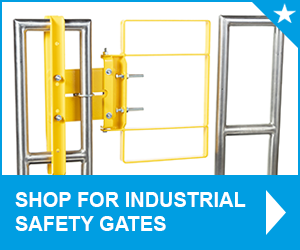
Inside your industrial facility, workers encounter many fall hazards. Mezzanines, catwalks, stairways, and other elevated surfaces all need to be equipped with fall protection equipment. While you may think of guardrails when you think about indoor fall protection, you should also be considering safety gates to keep workers safe. In our ongoing “Indoor Fall Protection FAQ Series,” this month we focus on self-closing safety gates and some of the most common questions regarding their use for fall protection.
What Is a Self-Closing Safety Gate?
As the name implies, a self-closing safety gate is metal safety gate that latches closed without any interaction from a person. Self-closing safety gates effectively eliminate the potential for a worker to forget to close the gate behind them, providing more protection than a standard gate that can be left open once a worker passes through. Industrial safety gates are designed to work in concert with a guardrail system to provide passive fall protection for workers who access areas 4′ or higher in your facility.
Where Are Safety Gates Used for Fall Safety?
The reality is that a self-closing safety gate is one of the most versatile forms of fall prevention you can invest in. Self-closing gates are extremely beneficial in a number of scenarios throughout an industrial facility. Some of the most common applications include:
Ladder and Stairway Entrances
Employees are constantly on the move, climbing ladders and stairs from lower levels to mezzanines and elevated platforms. Stairwell gates keep access points protected and allow workers to move through without interacting with the gate, eliminating the possibility that it’s left open.
Loading Docks
One of the busiest places in many industrial facilities is the loading dock area. Trucks arriving and departing all day, products, supplies, and equipment being moved around, and workers trying to get the job done make loading docks dangerous places. A metal safety gate on a dock minimizes traffic, prevents accidental entry, and can help protect dock workers from accidents.
Uneven Floor Levels
Whenever there’s a change in the elevation of a floor, it’s vital that employees are warned and protected from trip and fall accidents. A self-closing safety gate along with high-contrast warning labels and signs can help guide workers away from the fall hazard and safely on to their destination.
Restricted Areas
While some areas of your facility pose a fall hazard to workers, other spaces are sensitive to business operations or may contain mechanical or chemical hazards. You want to restrict access, and a self-closing, metal safety gate will limit who can enter the area and prevent unauthorized entry by closing immediately after an individual enters.
Does OSHA Require a Self-Closing Safety Gate?

What Specifications Do Self-Closing Safety Gates Have to Meet?
The OSHA guidelines for safety gates are the same as for guardrail systems and safety railings. If you’re using a guardrail for passive fall prevention and you’re also incorporating a safety gate, keep in mind that both must meet the following requirements:
- The top rail of guardrails and safety gates must be 42″ (plus or minus 3″) above the walking/working surface.
- Guardrails and swing gate top rails must be able to withstand 200 lbs. of downward force without failure and without deflecting to less than 39″.
- Midrails for safety railings or a metal safety gate must be able to handle 150 lbs. of downward or outward force without failing.
- Guardrails and, self-closing gates must be constructed of smooth material that won’t snag or scratch worker’s skin or catch clothing and equipment.
Do Self-Closing Gates Have to Be Safety Yellow?
One of the things that make safety gates so effective is that they stand out and attract the attention of workers. For this reason, safety gates are often painted in a highly visible, bright yellow. The truth is you can have your self-closing gates painted or powder-coated in any custom color you choose to suit your company’s brand identity or the style of your facility.
Are Self-Closing Gates Right for My Facility?
The only way to know for sure if a safety gate will be a good investment for your facility is to perform a safety inspection with a qualified individual. Take note of areas where a safety gate is generally used such as a ladder entrance or mezzanine access point. Evaluate your space to determine whether a swing-gate will work or if you need to find a vertical lift gate due to space restrictions or coverage needs.
Are Self-Closing Safety Gates Difficult to Install?
Actually, they’re quite simple to install and only require minimal tools. However, it should be noted that in order for a safety gate to operate as it is intended, it must be installed properly. To ensure that your safety gate meets OSHA guidelines and that it’s safe to use, rely on your qualified safety expert to guide the installation as recommended.
Where Can I Get OSHA-Compliant Self-Closing Safety Gates?
Fabenco is one of the most recognized names in the fall safety equipment industry with a well-earned reputation for high quality equipment and expert guidance. You can count on us to deliver for you. Our self-closing safety gates meet OSHA guidelines so you can rest assured your employees are safe and your company is in compliance with regulations.
Take action today and protect your workers with Fabenco fall protection. We’ll walk you through the process of choosing the right stairwell gates, modular guardrails, or safety harnesses and lanyards. And if we don’t have what you need, we’ll custom design something just for you. Contact one of our highly experienced fall safety experts today to learn more about self-closing safety gates that meet OSHA requirements.





